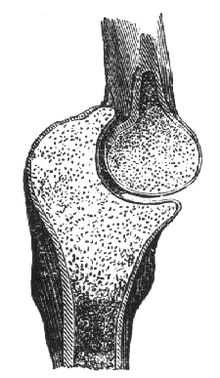Hinge joint
The hinge joint ( Latin ginglymus or articulatio ginglymus, from Greek ginglymos "door hinge") describes a shape variant of a real joint in anatomy . It consists of a roller-shaped joint head, which rests in a tong-shaped joint socket, which corresponds to the segment of a hollow cylinder. It is usually additionally stabilized by tight collateral ligaments and can also have bony guide ridges or grooves in the hyaline joint cartilage .
As a result of the mobility that is severely restricted by bony formations , the hinge joint has only one axis of movement or one degree of freedom and enables simple bending ( flexion ) and stretching ( extension ) movements.
Typical examples are:
- Articulatio humeroulnaris : joint between the humerus ( humerus ) and ulna , part of the elbow joint , articulatio cubiti
- Articulationes interphalangiales manus : finger joints : middle and end joints
- Articulatio talocruralis : upper ankle joint
literature
- Walther Graumann, Rolf Baur: Compact textbook anatomy. 1. General anatomy . Schattauer Verlag, 2004, ISBN 9783794520619 , p. 184.
